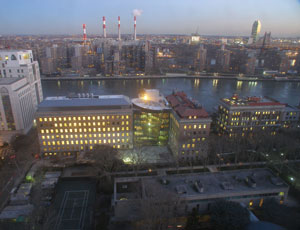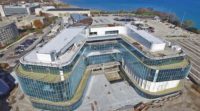Rockefeller University in New York has undertaken multiple projects to enhance its research facilities and modernize its historic campus to attract distinguished faculty.
The school selected Turner Construction Co. of New York as construction manager for the Collaborative Research Center (CRC), the recently completed the Comparative Biosciences Center and the Welch Hall renovation. Turner has worked with the university for more than 20 years, says Pat Di Filippo, executive vice president of Turner.
University officials declined to release costs for the project, indicating some of them are in flux. Turner also would not release cost for all of the projects.
In 2007, the university released an estimated price of $400 million for the CRC, but Turner reports being able to save significant costs on the Flexner Hall renovation. Design team Mitchell/Giurgola Architects of New York pegs the CRC’s cost at $280 million.
Collaborative Research Center The CRC features a new 60,000-sq-ft, eight-story, glass-enclosed structure, which serves as a bridging building between Smith Hall and Flexner Hall, two Neoclassical-style laboratory buildings, with a combined total of 200,000 sq ft. During the two-phased project, Turner will gut the two existing structures, built in 1930 and 1917 respectively, and renovate them to create large, open-plan laboratory spaces to accommodate more than 400 scientists.
“The sexy part of the project is the bridging building, but it was an important policy decision to preserve the existing buildings,” says Paul Broches, a partner with Mitchell/Giurgola, explaining that the cost and environmental impact of demolition would have been significant, yet renovating such old buildings into high-tech laboratory space presented challenges. For instance, the modest floor-to-floor heights in the existing buildings necessitated a packed core and four vertical shafts for mechanical and electrical distribution.
Mitchell/Giurgola designed the concrete addition and renovation to sustain the character of the urban campus, foster collaboration between scientists and incorporate sustainable features, such as a heat-recovery system, high-efficiency lighting and low-flow restroom fixtures.
The bridge building offers amenities and collaborative meeting spaces. It contains a 200-seat auditorium below grade and conference rooms, restrooms, elevators and snack pantries in a six-story, glass atrium with an open, central staircase.
“The idea is to bring people out of their cells and have accidental and intentional encounters,” says Jan Keane, a partner with Mitchell/Giurgola.
A European-fabricated glass curtain wall system, with conical-shaped glass that protrudes from the primary vertical glass toward the lawn, clads the west façade and a combination of limestone and curtain wall the east side. On upper floors a conference room occupies the conical opening, but the opening narrows as it extends to the first floor and remains open.
The project included a complete renovation of existing chiller plant and construction of a new 7,500-sq-ft underground electrical vault.





Post a comment to this article
Report Abusive Comment